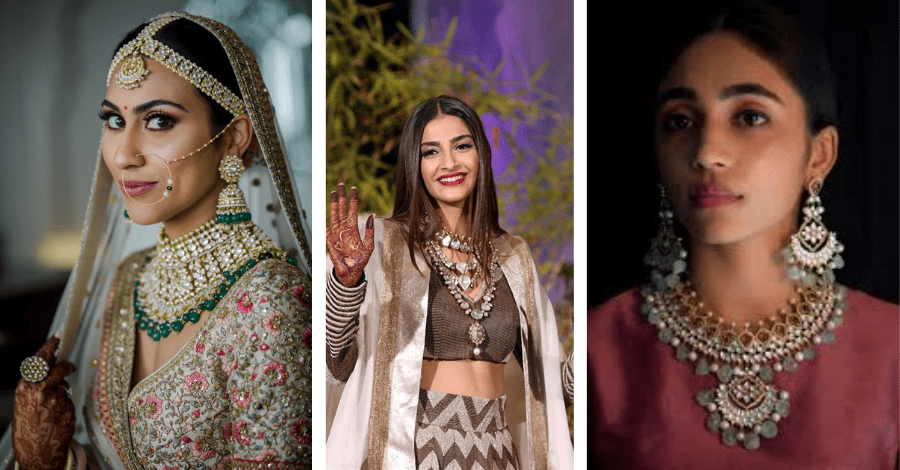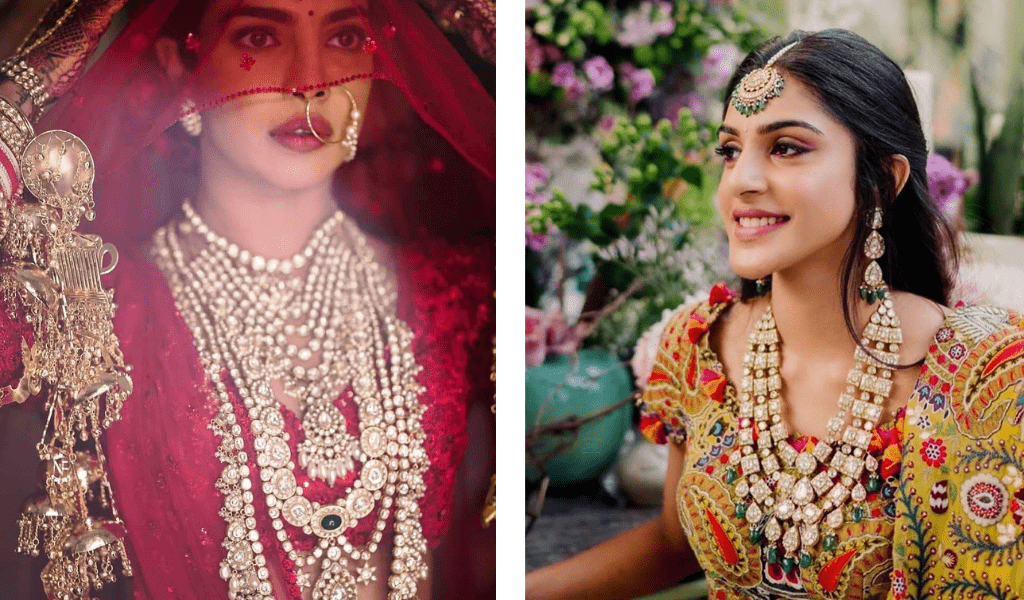
The Difference Between Kundan and Polki Jewellery
Last Updated on February 2, 2022 by Sagarika Kapoor
When it comes to wedding jewellery, we all know the difference between our gold and our diamonds. But haven’t you ever wondered if there is a difference between Kundan and Polki jewellery? The two can be very confusing to distinguish from each other. And why not? They look so similar. Yet, the difference between the two is immense. So, to clear the air, we have curated this article for you. After reading this, you will always know the difference between Kundan and Polki. You will know which bridal set will suit your needs the most. So, keep us in mind when going jewellery shopping for the big day. All you have to do now is continue reading!
What is the Difference Between Kundan and Polki Jewellery?
We know that you are reading this to find the difference between Kundan and Polki jewellery. But before we get to that, let’s discuss: what we mean by the two types of jewellery.
What is Polki Jewellery?
Polki is a term that refers to diamonds that are in their natural and raw form. Polki jewels are made from unprocessed diamonds that are in their pure form. The processing of these stones makes them look like the shiny diamonds we are familiar with. When compared to finished diamonds, Polki looks a little rustic.
Polki jewellery uses using gold foil with intricate designs at the back. The uncut diamonds are placed into these gold foils. When we compare it to Kundan Jewellery, Polki is quite expensive because of the diamonds. Yet, it is worth the investment as Polki jewellery makes for stunning heritage pieces. Additionally, it also looks phenomenal with bright gemstones.

Source: Ritika Kadam Hairstylist, Raniwala 1881
What is Kundan Jewellery?
Kudan jewellery is traditional Rajasthani jewellery that is made up of glass Polki. This means that glass stones are used to create these royal looking jewels. Additionally, there are no diamonds used in the making of Kundan jewellery. Glass stones are set in 24k gold, also known as Kundan, to create these traditional jewels. This is what makes Kundan jewellery look like Polki jewellery.
But, the process of making Kundan jewellery is more intense than that of Polki jewellery. The method is so elaborate that often you can find layers of stones in one set. Additionally, Kundan jewellery has a lot of intricate details at the back.

Source: Fida, Ayesha Makeup and Hair
Kundan jewellery includes both precious and semi-precious stones as well. Due to the use of glass stones instead of diamonds, Kundan is cheaper than Polki jewellery. Also, in contemporary times, there are various Kundan jewellery options available. These range from the use of silver instead of gold to grand artificial jewellery sets. These choices ensure that your bridal jewellery does not burn a hold in your pocket. This is why Kundan jewellery has become a popular choice amongst many brides for D-Day.
Where Did Kundan and Polki Jewellery Originate?
The process of making both Kundan and Polki jewellery is quite intense. Craftspeople have to train for years to be able to make these elaborate heritage jewels. Both Kundan and Polki jewellery is made using art that is hundreds of years old. The centuries-old art of making Polki jewellery dates back to the Mughal era. This was when it became a speciality of Bikaner in Rajasthan. But, Kundan jewellery was a staple in the royal household of Rajasthan. But gained patronage under the Mughal rule, flourishing as a consequence.

Source: Anita Dongre Pink City, Sunita Shekhawat
The Jadau Method
To know the difference between Kundan and Polki better, we should know how they are similar. We read already that their origins are years apart but have a crossover during the Mughal era. Besides this, the process of making Kundan and Polki jewellery is the same. This process refers to jadau. It is a form of the word “jad” which means root. With reference to making the jewellery, it means embedding stones into metal. Jadau is a very tedious and time-taking technique that takes years to master. It uses 24 karat gold to embed the stones for both kinds of jewellery. But since the stones are different, the end product is also different.

Source: Joseph Radhik, Anamika Khanna
Styl Tip: Both Kundan and Polki jewellery come in a variety of designs. So do your research before investing in one or the other.
Where Can You Buy the Jewellery?
Kundan and Polki are traditional Indian wedding jewellery. You can buy them anywhere in India. They are quite an investment for any bride. This is why you should get them from heritage shops in Rajasthan and Gujarat. These two states are the primary hubs of traditional jewellery. So, you will find the newest designs here.

Source: Birdhichand Ghanshyamdas, Sunita Shekhawaat
Difference Between Kundan and Polki
You have already figured out the difference between Kundan and Polki. But in case you did not, we have a list for you. This is especially for the ones who did not read the essay above. We know you’re there. Jokes apart, these are the key differences between the two types of jewellery
- Raw, uncut diamonds make up Polki jewellery
- Glass stones make up Kundan jewellery
- Polki is more expensive than Kundan
- The content of gold and diamond is more in Polki jewellery than in Kundan jewellery
- Polki is much more lustrous than Kundan jewellery
- Polki is often heavier than Kundan
- Artificial options for Kundan jewellery are widely available. But this is not the case with Polki jewellery
- Kundan jewellery originated from the Rajputana households. But, Polki dates back to the Mughal era
- There is enamel on the underside of Kundan jewellery. But Polki jewellery has gold foil at the back.
We hope that this article helped you know the difference between Kundan and Polki. For any help on wedding or personal styling, contact us at Styl Inc. Our team of expert stylists will get in touch with you. Stay tuned to Styl Inc blogs for more wedding styling tips and tricks.
Stay safe and healthy.
Keepin it Styl’ish
Signing off,
Shravani Priya
Disclaimer: We are not responsible if information made available on this site is not accurate, complete or current. The material on this site is provided for general information only and should not be relied upon or used as the sole basis for making decisions without consulting primary, more accurate, more complete or more timely sources of information. Any reliance on the material on this site is at your own risk. Any third-party trademarks, service marks, images and logos are the property of their respective owners. Any further rights not specifically granted herein are reserved.


No Comments